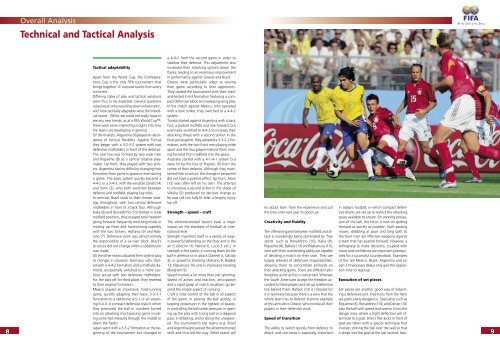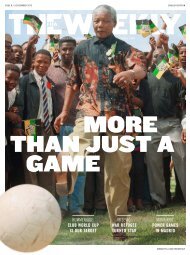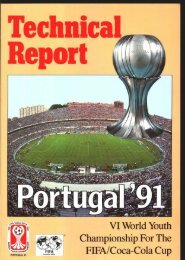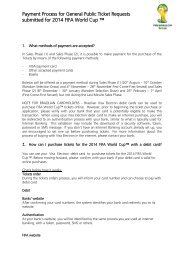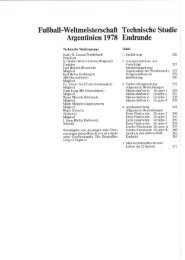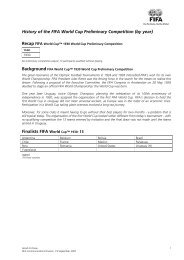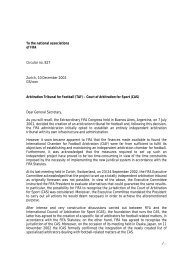You also want an ePaper? Increase the reach of your titles
YUMPU automatically turns print PDFs into web optimized ePapers that Google loves.
8<br />
Overall Analysis<br />
Technical and Tactical Analysis<br />
Tactical adaptability<br />
Apart from the World Cup, the Confederations<br />
Cup is the only <strong>FIFA</strong> tournament that<br />
brings together ‘A’ national teams from every<br />
continent.<br />
Differing styles of play and tactical variations<br />
were thus to be expected. General questions<br />
raised were ‘who would lay down what marks’,<br />
and ‘how tactically adaptable were the individual<br />
teams’. Whilst we could not really hope to<br />
see any new trends, as at a <strong>FIFA</strong> World Cup,<br />
there were some interesting insights into how<br />
the teams are developing in general.<br />
Of the finalists, Argentina displayed an abundance<br />
of tactical flexibility. Against Tunisia<br />
they began with a 3-2-3-2 system with two<br />
defensive midfielders in front of the defence.<br />
The next line was formed by two wide men<br />
and Riquelme (8) as a central creative playmaker.<br />
Up front, they played with two strikers.<br />
Argentina had no difficulty changing their<br />
formation from game to game or even during<br />
a game. The basic system quickly became a<br />
4-4-2 or a 3-4-3, with the versatile Zanetti (4)<br />
and Sorin (3), who both switched between<br />
defence and midfield, playing key roles.<br />
In contrast, Brazil stuck to their chosen strategy<br />
throughout, with two central defensive<br />
midfielders in front of a back four. Although<br />
Kaka (8) and Ronaldinho (10) started in wide<br />
midfield positions, they enjoyed total freedom<br />
going forward, frequently switching inside or<br />
moving up front and harmonising superbly<br />
with the two strikers, Adriano (9) and Robinho<br />
(7). Defensive work was almost entirely<br />
the responsibility of a six-man block. Brazil’s<br />
structure did not change when a substitution<br />
was made.<br />
All the other teams adjusted their style of play<br />
to changes in situation. <strong>Germany</strong>, who started<br />
with a 4-4-2 formation and a midfield diamond,<br />
occasionally switched to a more cautious<br />
set-up with two defensive midfielders.<br />
For the play-off for third place, they reverted<br />
to their original formation.<br />
Mexico played an impressive, hard-running<br />
game, quickly adapting their basic 3-3-3-1<br />
formation to a defensive 4-5-1 or an attacking<br />
3-4-3. A <strong>com</strong>pact defensive style in which<br />
they pressured the ball in numbers turned<br />
into an attacking short-passing game involving<br />
some fast interplay through the middle or<br />
down the flanks.<br />
Japan went with a 3-5-2 formation at the beginning<br />
of the tournament but changed to<br />
a 4-4-2 from the second game in order to<br />
stabilise their defence. This adjustment also<br />
increased their attacking options down the<br />
flanks, leading to an enormous improvement<br />
in performance against Greece and Brazil.<br />
Greece were particularly adept at varying<br />
their game according to their opponents.<br />
They started the tournament with their triedand-tested<br />
3-4-3 formation featuring a <strong>com</strong>pact<br />
defensive block and sweeping wing play.<br />
In the match against Mexico, who operated<br />
with a lone striker, they switched to a 4-4-2<br />
system.<br />
Tunisia started against Argentina with a back<br />
four, a packed midfield and one forward, but<br />
eventually switched to 4-4-2 to increase their<br />
attacking threat with a second striker. In the<br />
final group game, they adopted a 3-3-2-2 formation,<br />
with the two front men playing wide<br />
apart and the two players behind them moving<br />
forward from midfield into the space.<br />
Australia started with a 4-1-4-1 system but<br />
were hit by the loss of Popovic (6) from the<br />
centre of their defence. Although they maintained<br />
their structure, the change in personnel<br />
did not have a positive effect. Up front, Aloisi<br />
(15) was often left on his own. The attempt<br />
to introduce a second striker in the shape of<br />
Viduka (9) produced no decisive change as<br />
he was still not fully fit after a lengthy injury<br />
lay-off.<br />
Strength – speed – craft<br />
The aforementioned factors have a major<br />
impact on the standard of football at international<br />
level.<br />
Strength manifests itself in a variety of ways:<br />
in powerful defending on the floor and in the<br />
air (Coloccini 16, Heinze 6, Lucio 3 etc.); in<br />
strength in the tackle; in running duels for the<br />
ball in defence or in attack (Zanetti 4, Salcido<br />
3); in powerful shooting (Adriano 9, Ballack<br />
13, Nakamura 10) and in impressive heading<br />
(Borghetti 9).<br />
Speed involves a lot more than just sprinting.<br />
Speed of action and reaction, anticipation<br />
and a rapid grasp of match situations go beyond<br />
the simple aspect of running.<br />
Craft is total control of the ball in all aspects<br />
of the game: in passing the ball quickly; in<br />
keeping possession in the tightest of spaces;<br />
in controlling the ball under pressure; in opening<br />
up the play with a long ball or a diagonal<br />
pass; in dribbling; and in doing the unexpected.<br />
The tournament’s top teams (e.g. Brazil<br />
and Argentina) possessed the aforementioned<br />
skills and thus led the way. Other teams will<br />
no doubt learn from the experience and put<br />
the time until next year to good use.<br />
Creativity and fluidity<br />
The offensive game between midfield and attack<br />
is increasingly being dominated by ‘free<br />
spirits’ such as Ronaldinho (10), Kaka (8),<br />
Riquelme (8), Ballack (13) and Nakamura (10),<br />
who with their outstanding ability are capable<br />
of deciding a match on their own. They are<br />
largely relieved of defensive responsibilities,<br />
allowing them to concentrate primarily on<br />
their attacking game. There are different philosophies<br />
as far as this is concerned. Whereas<br />
the South Americans accept the freedom accorded<br />
to these players and set up a defensive<br />
line behind them, Ballack (13) is criticised for<br />
it in <strong>Germany</strong> because there is a view that the<br />
whole team has to defend. A prime example<br />
of this attitude is Greece, who involve all their<br />
players in their defensive work.<br />
Speed of transition<br />
The ability to switch quickly from defence to<br />
attack and vice-versa is especially important<br />
in today’s football, in which <strong>com</strong>pact defensive<br />
blocks are set up to restrict the attacking<br />
space available to a team. On winning possession<br />
of the ball, the focus is now on getting<br />
forward as quickly as possible. Swift passing<br />
moves, dribbling at pace and long balls to<br />
the front men are effective weapons against<br />
a team that has pushed forward. However, a<br />
willingness to make decisions, coupled with<br />
vision and confidence are important prerequisites<br />
for a successful counterattack. Examples<br />
of this are Mexico, Brazil, Argentina and Japan.<br />
Unnecessary delays only give the opposition<br />
time to regroup.<br />
Execution of set pieces<br />
Set pieces are another good way of breaching<br />
a defensive unit. Free-kicks from the flank<br />
are particularly dangerous. Specialists such as<br />
Riquelme (8), Ronaldinho (10) and Deisler (10)<br />
play the ball with speed and swerve it into the<br />
danger area, where a slight deflection will often<br />
lead to a goal. Direct free-kicks in front of<br />
goal are taken with a special technique that<br />
involves striking the ball over the wall so that<br />
it drops into the goal at the last second, leav-<br />
9


